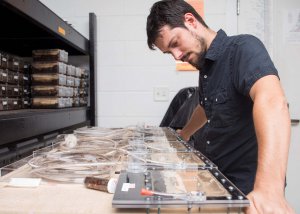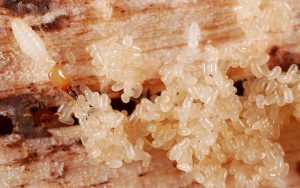- Termites are a concern for property owners as they are pests to property responsible for more than $32 billion in structural damage every year around the world.
- The Formosan subterranean termite is an invasive species that continues to spread and impact communities in many cities throughout the Southeast United States.
- A new study, led by researchers at the University of Florida at the Institute of Food and Agricultural Sciences (UF/IFAS), shows that eliminating a colony of subterranean termites begins by targeting eggs and ends with a starving queen.
DAVIE, Fla – Taking an extended look inside a subterranean termite colony is a rare and almost non-existent opportunity unless you raise one. But scientists like Thomas Chouvenc rear colonies from a king and queen, allowing them to produce thousands of eggs that grow to full maturity. In doing so, Chouvenc sheds a world of light on the species, the colony’s social behaviors, survival tactics and weaknesses.

Chouvenc, an assistant professor of urban entomology at the UF/IFAS Fort Lauderdale Research and Education Center (REC) produced colonies in his lab. The colonies of Formosan subterranean termites he raised are the subject of his latest study published in the Journal of Economic Entomology.
“Contrary to popular belief, you don’t have to kill the queen. In fact, it’s all about the eggs,” said Chouvenc. “In this study, we demonstrate the process of how subterranean termite colonies feeding on bait products that contain chitin synthesis inhibitors can be eliminated successfully from the inside. We also confirm these commercially available termite baits are effective because they are using an unexpected termite Achilles’ heel.”
“Traditionally, structures have been treated by spraying pesticides in the surrounding soils to prevent these invasive subterranean termites from accessing it. However, a series of studies in the past few years has suggested that such treatment may only temporarily limit the termite’s access. It has minimal impact on whole colonies,” he said.

Termite colonies that are treated with liquid termiticides can continue to access surrounding trees and other untreated structures and complete their life cycle. That way, they make new colonies within the community.
“While liquid termite treatments may provide a short-term solution for structures from subterranean termite problems, it has been shown that the use of subterranean termite baits can provide sustainable, long-term protection against such invasive subterranean termites,” said Chouvenc.
In previous studies, researchers confirmed that a termite bait treatment approach eliminates colonies that feed on it. In turn, eliminated colonies cannot contribute to the production of more termite colonies. That reduces the potential risk for damage to homeowner properties within the community. However, how termite baits work is sometimes misunderstood, said Chouvenc.
“It is commonly believed that to kill a termite colony, you need to kill the queen. It’s actually the opposite. Baited termite colonies at the end of their life would only display very old workers, and starving soldiers, the king and queen,” he said.
This led the research team to wonder what happens to the most vulnerable individuals within the colony — their precious brood.
“The queen lays eggs, which develop into larvae, but the whole brood depends on workers to help young ones develop. If the entire brood dies, then the colony is doomed because it cannot replace an aging population,” Chouvenc said.
In this new study, UF/IFAS researchers showed that as termites feed on the bait, they share the food with all other termites in the colony, including the queen and king. It does not directly kill termites, but as workers must engage in regularly molting — or replacing of their old skin — the bait activates and kills each worker as it fails to molt properly.
“We discovered that, as the queen is exposed to the bait by being fed by her workers, she loses the ability to lay viable eggs, and all larvae dies within 20 days, long before workers start dying — around 45 days after the start of the treatment,” Chouvenc said.
This finding revealed that, while it takes about 90 days to reach termite colony elimination with baits, the entire brood is already dead within 20 days. Meanwhile, the queen becomes incapable of laying new eggs. As workers progressively die by failing to molt, the queen and the king then die of starvation at the very end.
“Our study showed that, even if you see live termites in the bait station for a couple of months, all the eggs and larvae are already dead, and the colony has already reached a point of no return: the colony is already doomed for elimination,” Chouvenc said.
-30-
By: Lourdes Mederos, 954-577-6363
The mission of the University of Florida Institute of Food and Agricultural Sciences (UF/IFAS) is to develop knowledge relevant to agricultural, human, and natural resources and to make that knowledge available to sustain and enhance the quality of human life. With more than a dozen research facilities, 67 county Extension offices, and award-winning students and faculty in the UF College of Agricultural and Life Sciences, UF/IFAS brings science-based solutions to the state’s agricultural and natural resources industries, and all Florida residents.
ifas.ufl.edu | @UF_IFAS
 0
0
